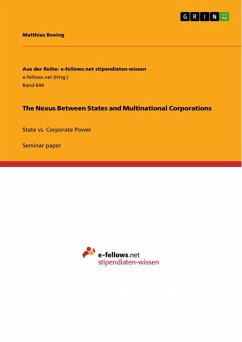Seminar paper from the year 2005 in the subject Business economics - General, grade: 2,3, European Business School - International University Schloß Reichartshausen Oestrich-Winkel, course: Managing the Global Economy, language: English, abstract: Globalization covers more and more countries and markets with increasing speed.1 Globalization is one of the most often used words of the present,2 but a clear definition is missing. Most of the times globalization is seen as a strong increase of the worldwide trade activities which includes the transboundary exchange of goods, services, capital as well as manpower.3 The structure of national barriers is broken up within the process of globalization to strengthen free trade and competition.4 Improvements in transportation, production and communication brought about new possibilities in the international division of labor, which brings along advantages to use scarce resources.5 Technological, political and institutional changes pushed the process of globalization through easier and faster access for market participants to goods, services and information from outside the home market.6 Globalization was not growing all by its own, but next to the improvements in technology the prerequisites were built by political initiatives like the GATT (General Agreement on Tariffs and Trade) or the liberalisation of the goods and financial markets.7 1 Vgl. SCHNEIDER (1998), S. 265; KAPILA (2002), S. 426. 2 Vgl. SCHMIDT (1998), S. 7. 3 Vgl. SOUNDARAPANDIAN (2003), S. 456; KAPILA (2002), S. 426. 4 Vgl. SOUNDARAPANDIAN (2003), S. 455; SANGMEISTER (2000), S. 9. 5 Vgl. ESCHENBURG/DABROWSKI (1998), Vorwort; SANGMEISTER (2000), S. 9. 6 Vgl. VANBERG (1998), S. 1. 7 Vgl. KÖSTERS, S. 377f.; SCHMIDT (1998), S. 33.









